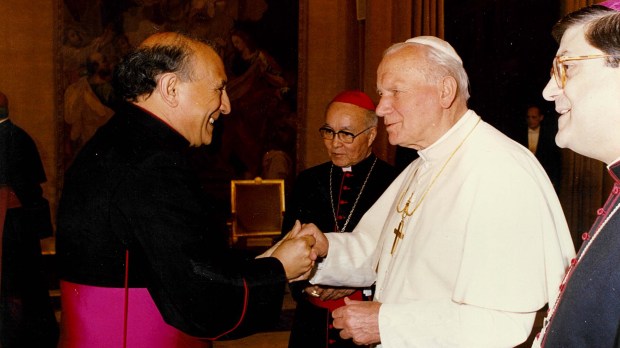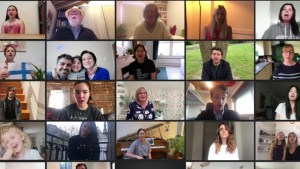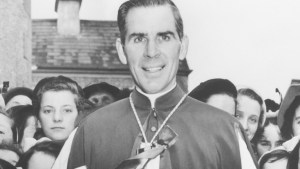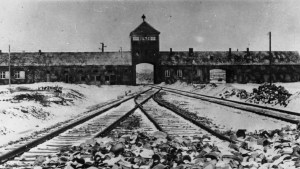The old recruiting slogan, “Join the Navy, See the World” could very well be adapted to the life of Msgr. Hilary C. Franco. Except that instead of going into military service, Msgr. Franco entered the service of the Church.
A priest for over 66 years, Msgr. Franco certainly has seen a great deal of the world — and the dramatic changes it has undergone at the beginning of a new millennium. Plus, having grown up in humble circumstances in an immigrant community in New York, he’s gotten to know personally some of the movers and shakers in the Church in our time.
At 89, Msgr. Franco is still working at the Holy See Mission to the United Nations in New York, following a long career at the Vatican. He has written an account of it all in a new book, Six Popes: A Son of the Church Remembers.
Stories of the six popes under whom Franco served — John XXIII, Paul VI, John Paul I, John Paul II, Benedict XVI, and Francis — are accompanied by reminiscences of other luminous figures he knew, such as Fulton Sheen, Padre Pio and Mother Teresa.
The son of Italian immigrants, Hilario Franco remembers figures of the doo-wop music scene in the Bronx borough of New York City, like Dion and the Belmonts, who took their name from the neighborhood young Franco inhabited. He was also close to the parish priests and entered the seminary himself, studying in Rome and eventually being ordained a priest of the Archdiocese of New York. He earned a degree in canon law and a doctorate in Biblical Theology at the Pontifical Lateran University and later a Master’s Degree in Sociology at Fordham University in New York.
But the formal education pales in comparison to the experiences of his priestly life.
“I had so many episodes in my life that really showed the providence of God,” Msgr. Franco said in an interview.
Serving Mass for Padre Pio
One of those episodes, which he calls “incredible and providential,” took place when he was 20 and turned out to be a defining moment in his long journey.
“I was at the Pontifical Lateran University at the time, and this archbishop was going down to see Padre Pio,” he recalled. The archbishop graciously allowed the young seminarian to accompany him.
“I remember the long line of people waiting outside,” he said. “The friary would open at 6:30 in the morning at the small church at that time — Santa Maria delle Grazie — now it’s a big shrine. Padre Pio would come down from his cell and celebrate Mass. Apparently some people were saying they’d been there since 2 o’clock in the morning. I guess that morning I was the only seminarian there who knew how to serve Mass, so I was asked by the friars to do so.”
Franco remembers the Mass beginning at 6:30 — and concluding at 9:30.
“It’s interesting how we — none of us in the church — did not realize that it took so long,” he said. “But we didn’t realize that Padre Pio would go into ecstasy during the Mass.”
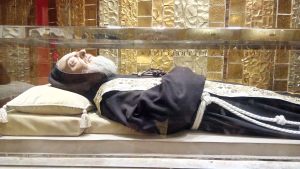
The celebrated stigmatist of Pietrelcina at the conclusion of the liturgy “turned to me and said ‘Young man, I was wondering if you could kind of lead me from the altar to the sacristy, help me take off my vestments, and take me back to my cell,’” Msgr. Franco said.
This gave the seminarian an opportunity to make his confession with the friar in his cell. “He was so gracious to tell me what he was hoping for me, but in that kind of hope it was almost a prophecy of what actually I would do,” he said.
“You can imagine, it was such a privilege for me,” Franco said. “That was one of the most important moments in my life, because we had a long, beautiful conversation, not only about my spiritual life but also the life I would be living in the future. It was quite an experience.”
Sheen’s piercing eyes
Franco was ordained two years later — at the age of 22. Thanks to a special papal dispensation, he became a priest earlier than the minimum age allowed at the time, which was 24.
It was natural for young Fr. Franco to return to the Bronx neighborhood where he grew up to now minister to the very vibrant Italian immigrant community — as a parish priest. But he was curious to meet an author he had read since his seminary days, New York Auxiliary Bishop Fulton J. Sheen. He hopped on the subway one day to go see him in Manhattan.
Similar to his not noticing how three hours passed when he assisted Padre Pio’s Mass, Franco was surprised when he realized that a 15-minute appointment with Bishop Sheen turned into a 43-minute meeting. Perhaps it was because, as he writes, Sheen’s “piercing, deep-set blue eyes bored holes in me.”
That initial interview led to a new assignment for the young parish priest. Sheen knew that Franco had a doctorate in biblical theology, so he asked if he would accompany him to Rome, where the bishop would serve on preparatory commissions for the Second Vatican Council in the areas of the Laity, Missions, and Communications.
The pope at the time was, of course, John XXIII, a man Franco had met while he was a seminarian and the future pontiff was known as Archbishop Angelo Giuseppe Roncalli.
Franco became special assistant to Bishop Sheen, who was not only a well-known and loved television preacher but also head of the National Office of the Propagation of the Faith in Manhattan. Living in the same residence as Sheen and working with him allowed Franco to see the human side of the man, as well as the spiritual. Sheen provided advice and spiritual guidance to many prominent people, including Ronald Reagan, Loretta Young, Salvador Dali, King Baudouin of Belgium, George Jessel, Jack Benny and Maureen O’Hara. He shepherded people like Clare Booth Luce and Henry Ford II into the Catholic Church.
None of that went to his head, in Franco’s view.
“The first morning I was with him, I felt I had to go down to the chapel earlier to see that everything was set,” Franco recalled. “I come down the steps from my apartment and see a light in the chapel on the main floor. And I think, ‘Look at my first boo-boo, because probably last night I forgot to turn the light off.’
“And I open the door, and there he was, kneeling down in front of the tabernacle, on that kneeler. He would stay kneeling in front of his Lord until 7:30, and then he’d serve my Mass — in those days, there was no concelebration — and then at 8 o’clock I would serve his Mass. Then we’d go down to have breakfast and go to the office.”
The two men normally walked across Manhattan to the Society for the Propagation’s office, a 10-minute stroll for most people. For Sheen, though, it took much longer, as he was besieged by well-wishers asking to have a word, an autograph, or a photo. He humbly gave anyone the time and attention they required.
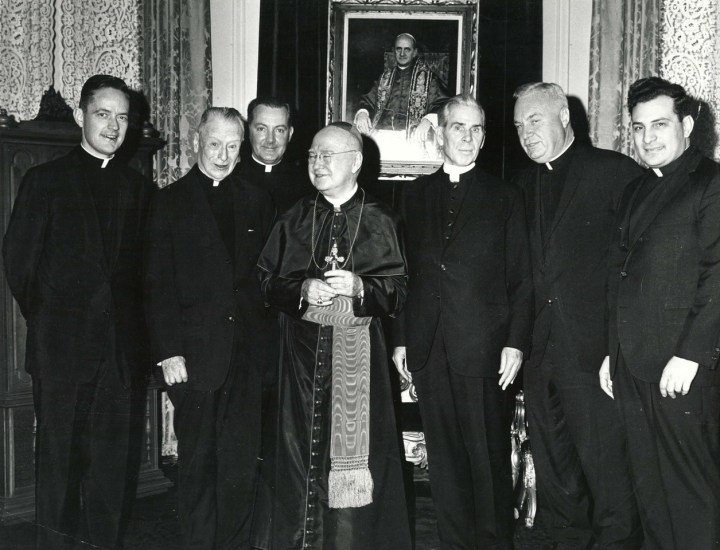
Aside from entertaining famous dinner guests at his residence, Sheen welcomed others who never would have made headlines. “I remember Victor Anderson, a cured leper, who was not really wanted by his family,” Franco said. “The bishop … not only provided an apartment for him but also almost every Friday we had him for dinner.”
Witness to history
In 1967, Franco became the first New York priest to serve in the Vatican’s Diplomatic Corps at the Apostolic Delegation to the United States in Washington. He and Sheen stayed in touch, even as the young priest returned to Rome, and the 100 letters Franco still has from the bishop form the basis of an earlier book, Bishop Fulton J. Sheen: Mentor and Friend.
From 1968 to 1970 Franco was an Official of the Prefecture for Economic Affairs of the Holy See, before being named an official of the Congregation of the Clergy, manning the English Desk at the Vatican for 24 years.
So he was there on May 13, 1981, when Pope John Paul was giving a Wednesday audience — an otherwise ordinary day until gunshots rang out as the popemobile was making its way around St. Peter’s Square. Franco had first met the pope years earlier, when then-Bishop Karol Wojtyla came to the Second Vatican Council.
“I had an immediate liking of the man,” he said. “He was just a little bit older than me. We struck up a beautiful friendship that continued until he would become pope and I would be serving him.”
Franco’s “boss” at the time, Fulton Sheen, took an interest in the young auxiliary bishop of Krakow, because the Polish archdiocese had so many priestly vocations but didn’t have enough space in the seminary. “As always, Fulton Sheen would be so generous in helping the missions behind the Iron Curtain,” Franco said.
Fast forward to 1981, the day of the assassination attempt on John Paul was “kind of hot, so I opened the huge window in my office” facing St. Peter’s Square and Basilica, Franco recalled. “I was working, sitting down, and the usual noise of the crowd in the square was in the background. I was accustomed to the crowd preparing for the homily or the address of the Pope. So I didn’t really pay attention. I would sit down and work. And then all of a sudden something happened — that noise disappeared, and there was like a humming sound. I ran to the window and realized the situation, then went down. It was 5:21 p.m. on that infamous day.”
He did hear something like gunshots, but figured it could have been fireworks or something. “How could you ever imagine that something like that could even happen. Even if you hear something, … you figure it’s an expression of joy, not of sorrow. Who would expect something like that? No one. No one.”
Happily, the pope survived the assassination attempt, and Franco went on to serve him until he returned to New York to take up a pastorate.
In 2013, now in his 80s, rather than retiring, he put his experiences and expertise at the service of the Permanent Observer of the Holy See to the United Nations.
“I was asked to be an adviser here,” he said, speaking from his office on East 39th Street in Manhattan, not far from where he lived and worked with Fulton Sheen. “We have so many interventions we prepare here. We have the blessing of the Secretary of State in Rome. Human rights, women, children from conflict areas” are the subjects that occupy his attention these days.
“And there is such a support from most of the 193 delegations we have here at the U.N. We try to create a friendly companionship with the embassies that are here. So far we’ve been successful.”
It’s a world away from his humble beginnings, though only a matter of miles from the Belmont neighborhood where he first learned his faith from his Italian immigrant parents.
Indeed, Six Popes is a book of many memories — mostly happy ones, but also lessons from which Msgr. Franco hopes his readers may benefit.
“As a power of the human spirit, memory is as great as it is mysterious,” he concludes in the book. “When we record our memories, we contribute to a history that, as Cicero aphorized, is the teacher of life; when we exercise this power, we preserve it. Use it or lose it.”
Says this veteran priest, “I hope I’ve used it well.”
